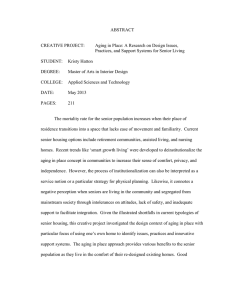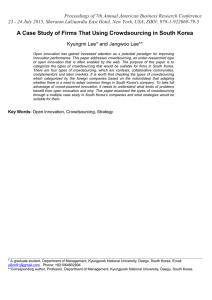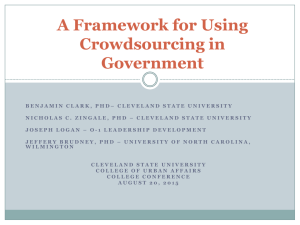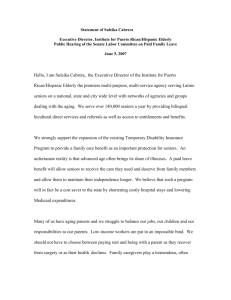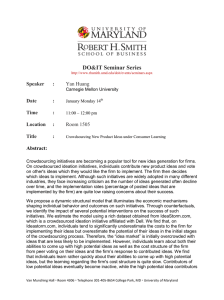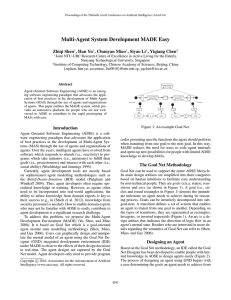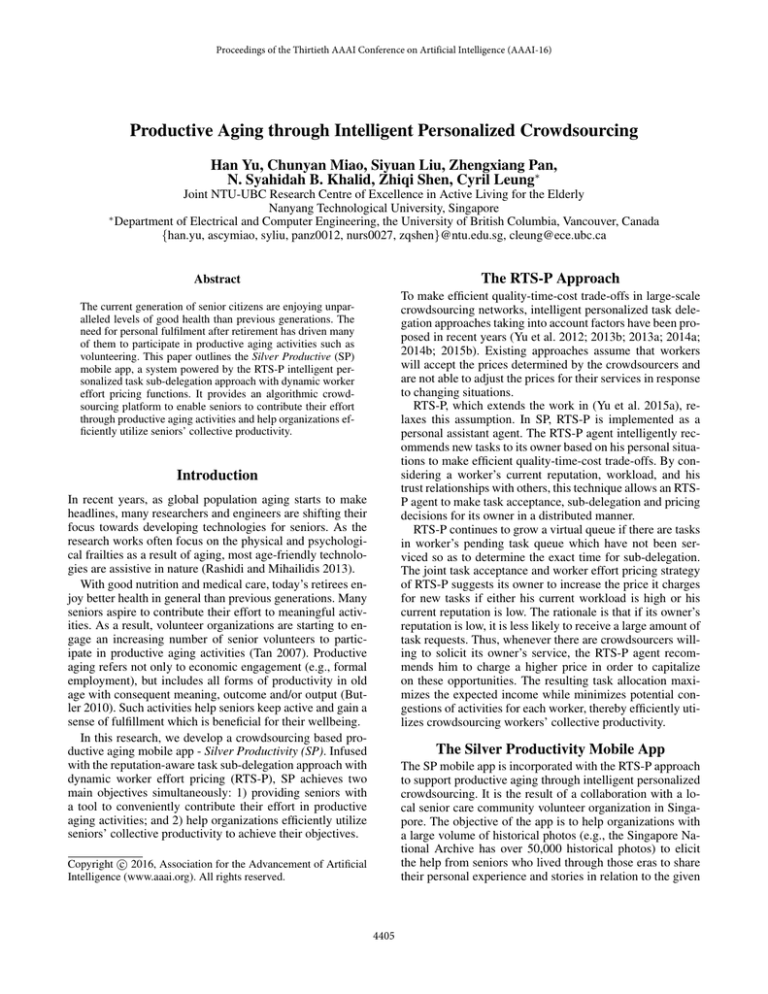
Proceedings of the Thirtieth AAAI Conference on Artificial Intelligence (AAAI-16)
Productive Aging through Intelligent Personalized Crowdsourcing
Han Yu, Chunyan Miao, Siyuan Liu, Zhengxiang Pan,
N. Syahidah B. Khalid, Zhiqi Shen, Cyril Leung∗
Joint NTU-UBC Research Centre of Excellence in Active Living for the Elderly
Nanyang Technological University, Singapore
∗
Department of Electrical and Computer Engineering, the University of British Columbia, Vancouver, Canada
{han.yu, ascymiao, syliu, panz0012, nurs0027, zqshen}@ntu.edu.sg, cleung@ece.ubc.ca
The RTS-P Approach
Abstract
To make efficient quality-time-cost trade-offs in large-scale
crowdsourcing networks, intelligent personalized task delegation approaches taking into account factors have been proposed in recent years (Yu et al. 2012; 2013b; 2013a; 2014a;
2014b; 2015b). Existing approaches assume that workers
will accept the prices determined by the crowdsourcers and
are not able to adjust the prices for their services in response
to changing situations.
RTS-P, which extends the work in (Yu et al. 2015a), relaxes this assumption. In SP, RTS-P is implemented as a
personal assistant agent. The RTS-P agent intelligently recommends new tasks to its owner based on his personal situations to make efficient quality-time-cost trade-offs. By considering a worker’s current reputation, workload, and his
trust relationships with others, this technique allows an RTSP agent to make task acceptance, sub-delegation and pricing
decisions for its owner in a distributed manner.
RTS-P continues to grow a virtual queue if there are tasks
in worker’s pending task queue which have not been serviced so as to determine the exact time for sub-delegation.
The joint task acceptance and worker effort pricing strategy
of RTS-P suggests its owner to increase the price it charges
for new tasks if either his current workload is high or his
current reputation is low. The rationale is that if its owner’s
reputation is low, it is less likely to receive a large amount of
task requests. Thus, whenever there are crowdsourcers willing to solicit its owner’s service, the RTS-P agent recommends him to charge a higher price in order to capitalize
on these opportunities. The resulting task allocation maximizes the expected income while minimizes potential congestions of activities for each worker, thereby efficiently utilizes crowdsourcing workers’ collective productivity.
The current generation of senior citizens are enjoying unparalleled levels of good health than previous generations. The
need for personal fulfilment after retirement has driven many
of them to participate in productive aging activities such as
volunteering. This paper outlines the Silver Productive (SP)
mobile app, a system powered by the RTS-P intelligent personalized task sub-delegation approach with dynamic worker
effort pricing functions. It provides an algorithmic crowdsourcing platform to enable seniors to contribute their effort
through productive aging activities and help organizations efficiently utilize seniors’ collective productivity.
Introduction
In recent years, as global population aging starts to make
headlines, many researchers and engineers are shifting their
focus towards developing technologies for seniors. As the
research works often focus on the physical and psychological frailties as a result of aging, most age-friendly technologies are assistive in nature (Rashidi and Mihailidis 2013).
With good nutrition and medical care, today’s retirees enjoy better health in general than previous generations. Many
seniors aspire to contribute their effort to meaningful activities. As a result, volunteer organizations are starting to engage an increasing number of senior volunteers to participate in productive aging activities (Tan 2007). Productive
aging refers not only to economic engagement (e.g., formal
employment), but includes all forms of productivity in old
age with consequent meaning, outcome and/or output (Butler 2010). Such activities help seniors keep active and gain a
sense of fulfillment which is beneficial for their wellbeing.
In this research, we develop a crowdsourcing based productive aging mobile app - Silver Productivity (SP). Infused
with the reputation-aware task sub-delegation approach with
dynamic worker effort pricing (RTS-P), SP achieves two
main objectives simultaneously: 1) providing seniors with
a tool to conveniently contribute their effort in productive
aging activities; and 2) help organizations efficiently utilize
seniors’ collective productivity to achieve their objectives.
The Silver Productivity Mobile App
The SP mobile app is incorporated with the RTS-P approach
to support productive aging through intelligent personalized
crowdsourcing. It is the result of a collaboration with a local senior care community volunteer organization in Singapore. The objective of the app is to help organizations with
a large volume of historical photos (e.g., the Singapore National Archive has over 50,000 historical photos) to elicit
the help from seniors who lived through those eras to share
their personal experience and stories in relation to the given
c 2016, Association for the Advancement of Artificial
Copyright Intelligence (www.aaai.org). All rights reserved.
4405
(a) User Profile
(b) Recommended Photos (c) Providing tags to a Photo (d) Sharing feelings for a
Photo
Figure 1: Screenshots of the Silver Productivity mobile app.
References
photos. Currently, a point-based system instead of money is
used in the app to price workers’ effort (Figure 1(a)).
Figure 1 shows screenshots from the app demonstrating its main functionalities. These include: 1) understanding
user characteristics based on their profile information (Figure 1(a), with private information censored), 2) the RTS-P
agent recommending photos to a user automatically (Figure 1(b)), 3) the interface for a user to provide tags about
various aspects of the contents depicted by a selected photo
(Figure 1(c)), and 4) the interface for a user to share feelings
evoked by the contents of a selected photo (Figure 1(d)). The
emoticon in the app to collect user contributed feelings is derived from the AffectButton (Broekens 2014). Based on the
learning models derived from a large-scale user study (Yu,
Salmon, and Leung 2015), the app can automatically convert
the users choice of the smiley face to composite emotions.
Functions to collect user contributed text and audio descriptions about a given photo are also available.
Broekens, J. 2014. The affectbutton: a digital self-report tool
for emotion. In CHISparks’14, 158–159.
Butler, R. O. 2010. The Longevity Prescription: The 8 Proven
Keys to a Long, Healthy Life. Avery, New York.
Rashidi, P., and Mihailidis, A. 2013. A survey on ambientassisted living tools for older adults. IEEE Journal of Biomedical and Health Informatics 17(3):579–590.
Tan, C. K. 2007. Engaging senior volunteers: A guide for
non-profit organisations. Technical report, National Volunteer
and Philanthropy Centre, Singapore.
Yu, H.; Shen, Z.; Miao, C.; and An, B. 2012. Challenges
and opportunities for trust management in crowdsourcing. In
IAT’12, 486–493.
Yu, H.; Miao, C.; An, B.; Leung, C.; and Lesser, V. R. 2013a.
A reputation management model for resource constrained
trustee agents. In IJCAI’13, 418–424.
Yu, H.; Shen, Z.; Miao, C.; and An, B. 2013b. A reputationaware decision-making approach for improving the efficiency
of crowdsourcing systems. In AAMAS’13, 1315–1316.
Yu, H.; Miao, C.; An, B.; Shen, Z.; and Leung, C. 2014a.
Reputation-aware task allocation for human trustees. In AAMAS’14, 357–364.
Yu, H.; Yu, X.; Lim, S. F.; Lin, J.; Shen, Z.; and Miao, C.
2014b. A multi-agent game for studying human decisionmaking. In AAMAS’14, 1661–1662.
Yu, H.; Miao, C.; Shen, Z.; Leung, C.; Chen, Y.; and Yang,
Q. 2015a. Efficient task sub-delegation for crowdsourcing.
In AAAI-15, 1305–1311.
Yu, H.; Miao, C.; Shen, Z.; and Leung, C. 2015b. Quality
and budget aware task allocation for spatial crowdsourcing.
In AAMAS’15, 1689–1690.
Yu, X.; Salmon, C. T.; and Leung, C. 2015. Emotional interactions between artificial companion agents and the elderly.
In AAMAS’15, 1991–1992.
Discussions and Future Work
With RTS-P, SP helps workers determine the amount of new
tasks they should accept at any given time. In addition, SP
supports two important decisions: 1) the price for one’s effort, and 2) when and how much of one’s pending workload
should be sub-delegated at a given time and to whom, which
are not supported by existing crowdsourcing systems. In future research, we will investigate how workers respond to
the RTS-P agents’ suggestions through user studies.
Acknowledgements
This research is supported, in part, by the National Research
Foundation, Prime Minister’s Office, Singapore under its
IDM Futures Funding Initiative and administered by the Interactive and Digital Media Programme Office; and the Lee
Kuan Yew Post-Doctoral Fellowship Grant.
4406


